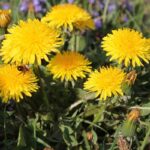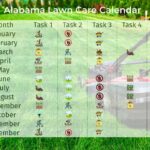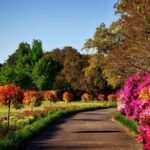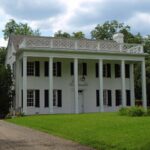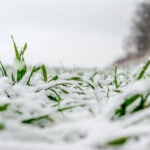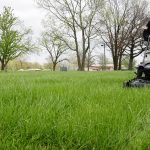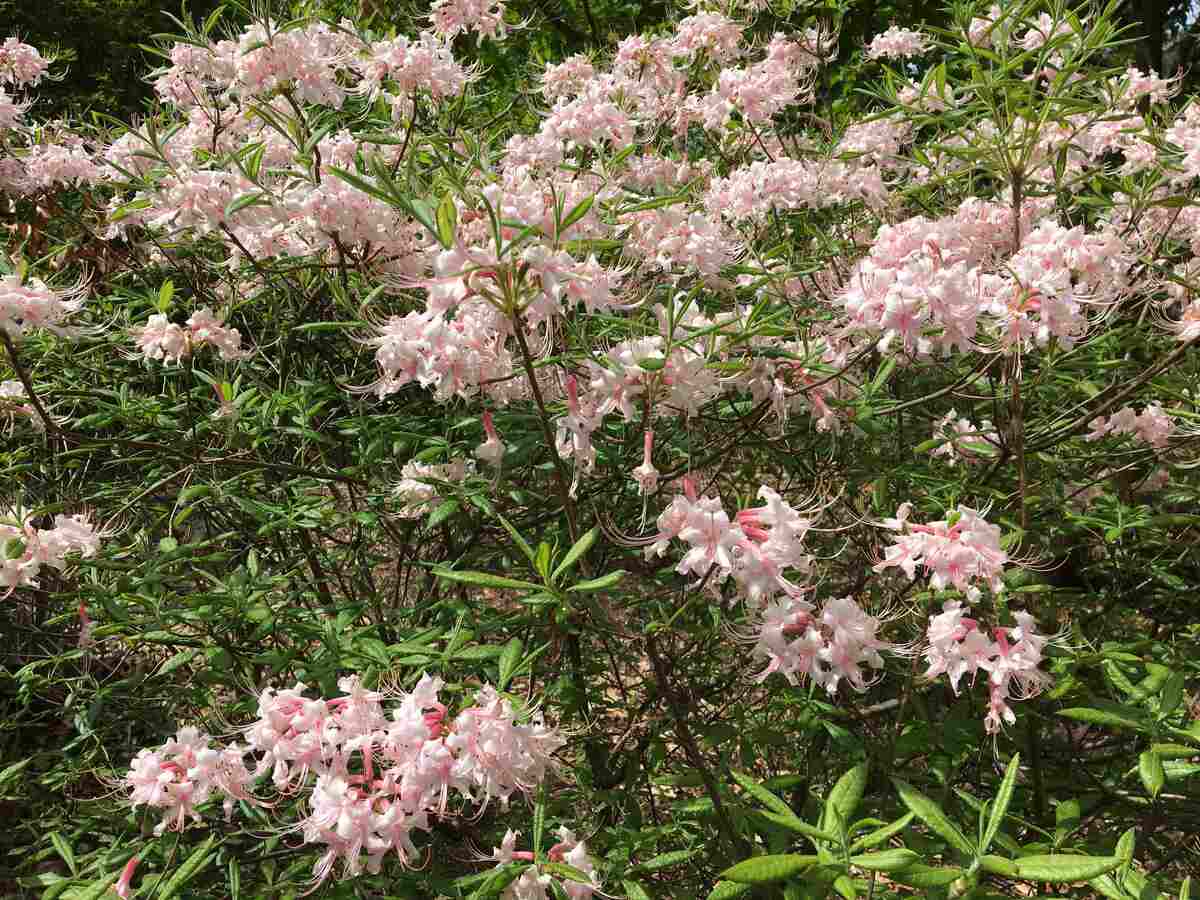
We all might be guilty of admiring the exotic, non-native plants that adorn Alabama landscapes without stopping to think about the native plants that have been thriving here for ages. But those natives are part of the Heart of Dixie’s biodiversity, and they were here long before the first human settlers.
Alabama’s native plants are the backbone of the state’s ecosystem, and many of them make great additions to a home landscape!
Let’s check out some real champions, the most resilient native plants that deserve a place in Alabamans’ hearts and gardens.
Native Alabama Flowers
First up: native flowers. Every Alabaman should know that these flowers are part of the state’s natural heritage, and they’re much better choices for your garden than non-natives. These glowing stars of the showroom are a feast for the eyes (and, in many cases, the nose)!
1. Climbing Aster (Ampelaster carolinianus)
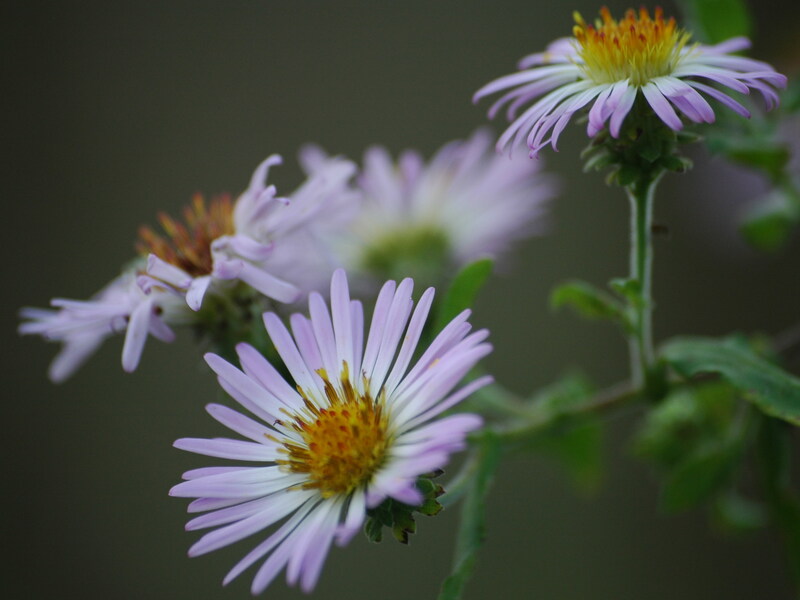
This hardy plant is a real showstopper. It boasts beautiful purple flowers that cascade over fences and near trees, adding a stunning touch of color to your outdoor space. With very little maintenance, this perennial plant can reach heights up to ten feet and is delightfully fragrant.
In late summer through early fall, the climbing aster will burst into bloom, making your landscape look like a postcard. Usually found near swamps, streams, and marshy areas, this Southern plant will happily thrive in areas with full sun and plenty of water. You can find it growing in the southernmost parts of Alabama, mainly around Mobile County and the Gulf Coast.
- Hardiness zones: 7 – 10
- Sun: Full sun
- Soil type: Clay, Loam, Sand
- Duration: Perennial
- Height: 10-12 inches
- Maintenance: Provide something for them to lean on as they grow. Don’t prune over the winter. Water regularly.
2. Many-Flowered Grass-Pink (Calopogon multiflorus)
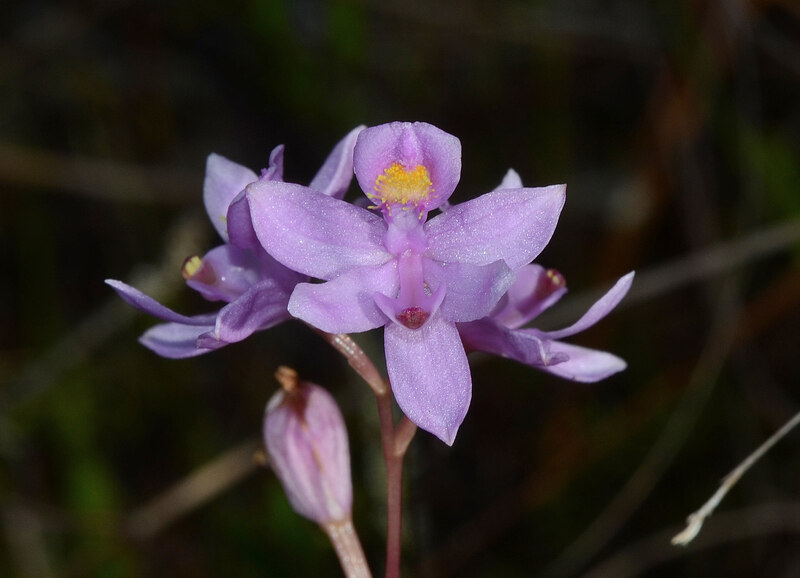
Here’s another pretty wildflower that helps make us Alabama the Beautiful. The many-flowered grass pink is a delicate orchid that blooms in early spring and produces simple but elegant pink flowers with long blossoms.
Growing mainly in the coastal region of Alabama, it is rare to find this beautiful gem. But if you’re lucky, you can be sure it will reward you with a fabulous show of majestic pink and magenta petals with a hint of yellow. Plus, this flower has a delicately sweet fragrance.
The many-flowered grass-pink plant prefers acidic and sandy soils and can tolerate full sun or partial shade.
- Hardiness zones: 4 – 10
- Sun: Full sun/Partial shade
- Soil type: Acidic, sandy soil
- Duration: Perennial
- Height: Up to 12 inches
- Maintenance: Water regularly
3. Bandanna of the Everglades (Canna flaccida)
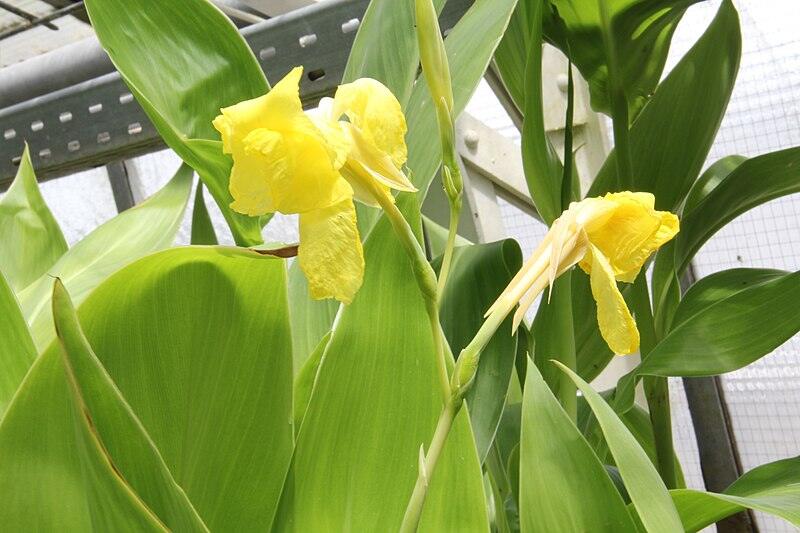
One of the belles of Alabama’s wildflower repertoire is the bandanna of the Everglades. It’s an incredibly resilient and showy perennial that grows to around 4 feet tall and bears large, bright yellow flowers surrounded by long, lance-shaped leaves. The flowers usually appear in the summer and will attract bees and butterflies.
Found mainly in swamps and wet regions such as the Mobile Bay shores, this plant will tolerate full sun and a wide range of soil types, from sandy to loamy.
- Hardiness zones: 8 – 11
- Sun: Full sun
- Soil type: Moist sandy, loamy, or clay soil
- Duration: Perennial
- Height: 3-5 feet
- Maintenance: It needs plenty of water.
4. Fire Pink (Silene virginica)
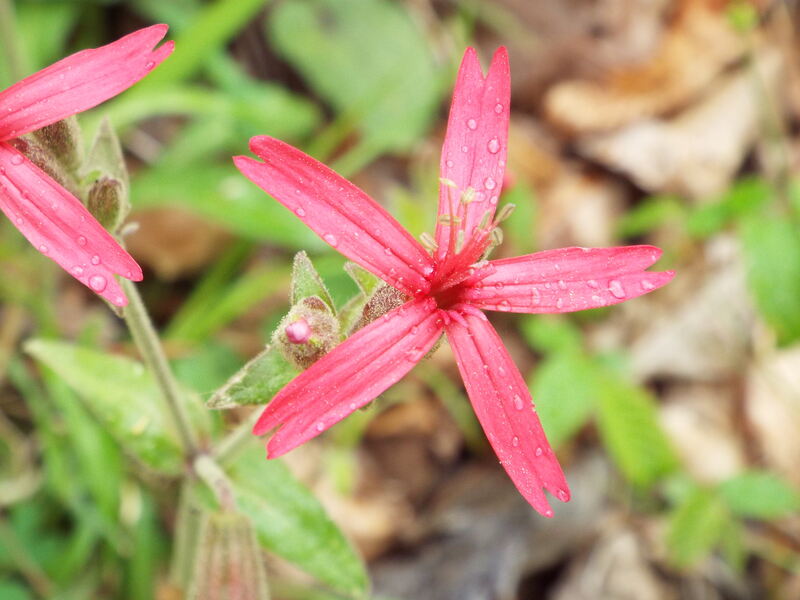
Eye-catching vibrant red petals make this wildflower a must-have in a colorful landscape. The popular fire pink grows in hedgerows and wooded areas across Alabama, especially in northern regions of the state.
Fire pink usually blooms in spring, reaching up to two to four feet high. It needs full or partial sun and prefers a mesic to dry soil that drains well. The fire pink is relatively low maintenance, and once it’s established, it is drought-tolerant.
Plus, the blooms attract lovely butterflies and hummingbirds. If you’re lucky, the flowers may even reseed themselves! The good news is fire pink may be found in native plant nurseries, too.
- Hardiness zones: 4 – 8
- Sun: Full sun/Partial shade
- Soil type: Dry to medium moisture, well-drained soil
- Duration: Perennial
- Height: 2-4 feet
- Maintenance: Low maintenance, drought tolerant once established.
5. American Bluehearts (Buchnera americana)
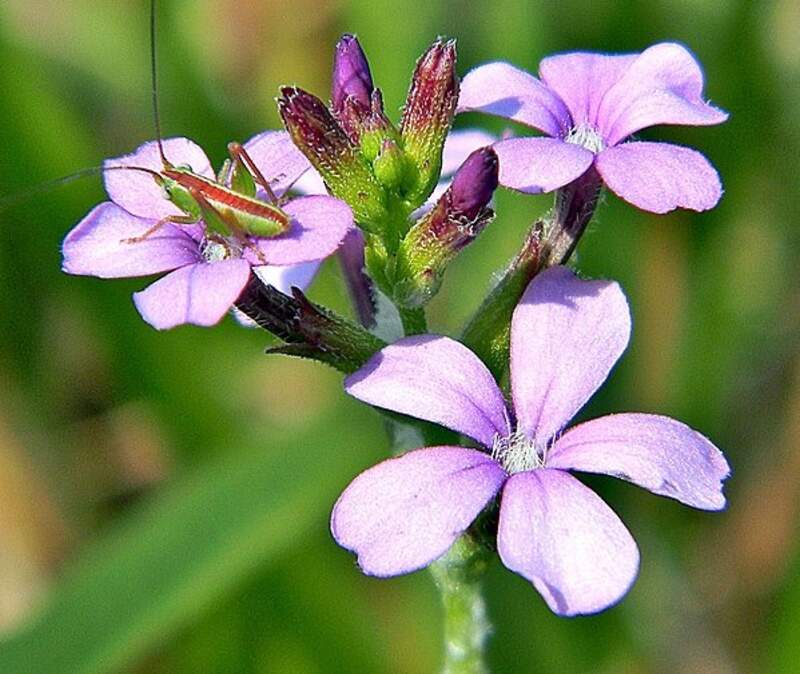
With its small but brilliant, deep blue blooms, American bluehearts are one of Alabama’s true wild beauties. The flowers usually appear in June and remain until September. These resilient plants have hairy, rough stems and leaves that darken on contact. As the flowers age, they turn black before spreading their seeds.
American bluehearts are partially parasitic, meaning they can form knobby, tuberous connections to existing roots to acquire nutrients – so be careful planting them next to other plants in your garden. They thrive in sunny areas and moist, well-drained soils and are part of the Broomrape family.
- Hardiness zones: 8 – 11
- Sun: Full sun
- Soil type: Moist to wet, well-drained sandy or calcareous soils
- Duration: Perennial
- Height: Up to 3 feet
- Maintenance: Moderate drought tolerance, fast-growing
6. Eastern Columbine (Aquilegia canadensis)
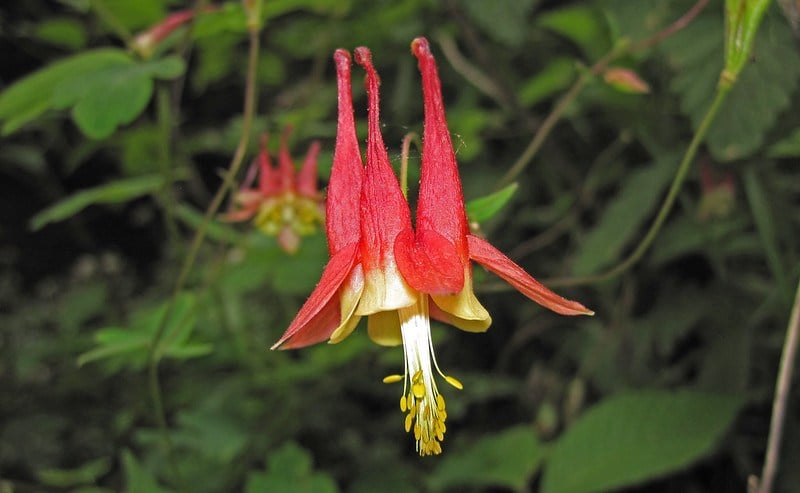
The eastern columbine’s striking red and yellow petals bobbing in the breeze as it stands proud in its garden bed is a truly majestic sight. Native to northern Alabama, the eastern columbine is generally quite easy to care for and incredibly adaptable. It performs well in sunny and shady positions as long as the soil is wet but well-drained.
You can find this wildflower happily growing in wet areas near waterways and streams, where it will produce a cheerful explosion of red-and-yellow blooms in late spring or early summer. It can also be found in nurseries, so it’s easy to bring some of this wild beauty into your backyard.
- Hardiness zones: 3 – 8
- Sun: Full sun
- Soil type: Well-draining soils, even sandy soils
- Duration: Perennial
- Height: 4-6 feet
- Maintenance: Water regularly
7. Swamp Mallow (Hibiscus coccineus)
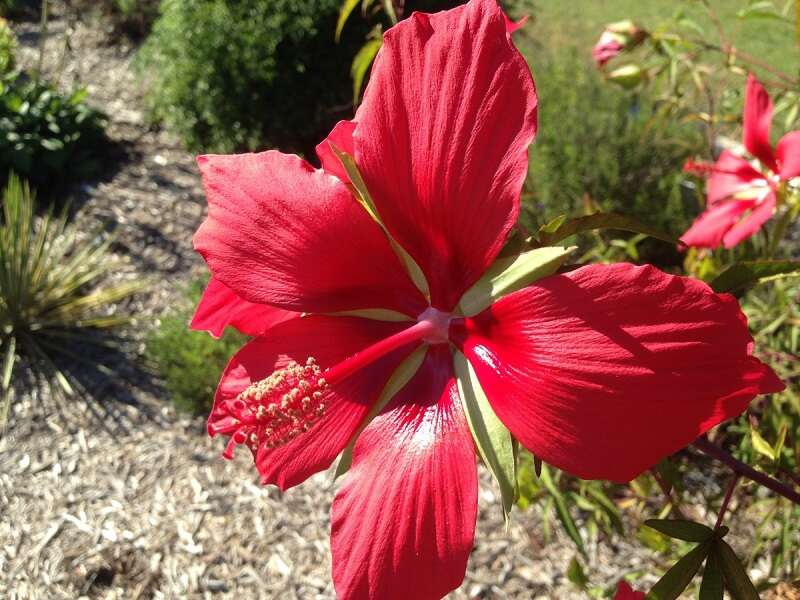
The swamp mallow, also known as the scarlet hibiscus, is a gorgeous wildflower native to southern Alabama and a member of the Malvaceae family. Notable for its huge, red, triangular flowers from summer until fall, it grows up to around six to eight feet and has multiple stems rising from its base.
It’s currently quite rare, listed as an S1 species, with only five occurrences found in Alabama, so you’re lucky if you come across it. This herbaceous perennial prefers to live in wet soil that’s rich in humus, and exposure to full sunlight is best. But it can also tolerate some shade once established. It’s possible to find it pre-cultivated in nurseries from either cuttings or seeds.
- Hardiness zones: 8 – 10
- Sun: Full sun, partial shade
- Soil type: Prefers wet soil but can tolerate some drier soils
- Duration: Perennial
- Height: 4-8 feet
- Maintenance: Check for pests regularly; Water regularly; Mulch in winter.
Native Alabama Shrubs
Next on our list are some of Alabama’s native shrubs. From dense, evergreen varieties to those with blooms, like azaleas, they can add plenty of color and texture to your landscape. Some of these specimens are incredibly tough, able to withstand extreme temperatures and humidity with ease. Others can provide brilliant displays of bright summer hues.
8. Alabama Azalea (Rhododendron alabamense)
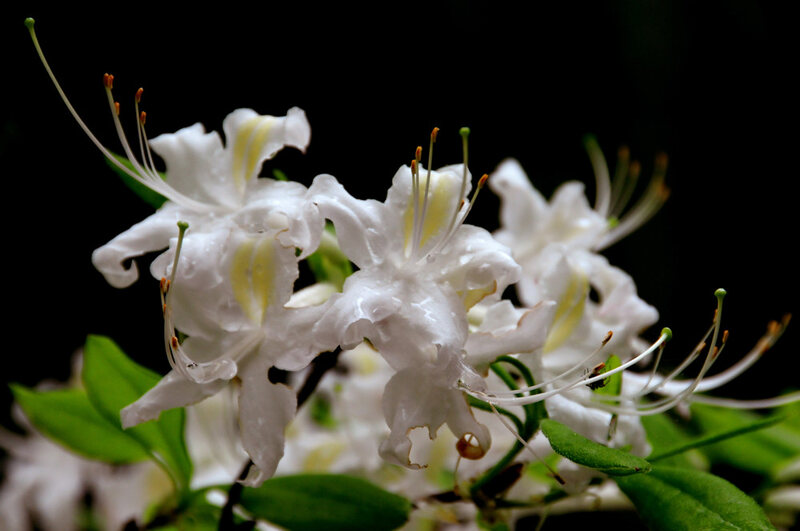
This is the state’s wild azalea – a true Alabama resident and one of the largest native azaleas. It can reach a height of 15 feet and boasts lovely white or pink-tinged blooms with a yellow blotch in the center.
On top of that, it has a delightful lemon-like fragrance. It can usually be found on slopes, ridges, hillsides, and woodlands in sandy loam or clay soils with partial shade. Enjoy the show of blooms from late spring through early summer.
- Hardiness zone: 7 – 8
- Sun: Partial Sun/Shade
- Soil type: Sandy Loam or Clay Soils
- Duration: Perennial
- Height: Up to 12 feet
- Maintenance: Low maintenance, water regularly
9. Beautyberry (Callicarpa Americana)
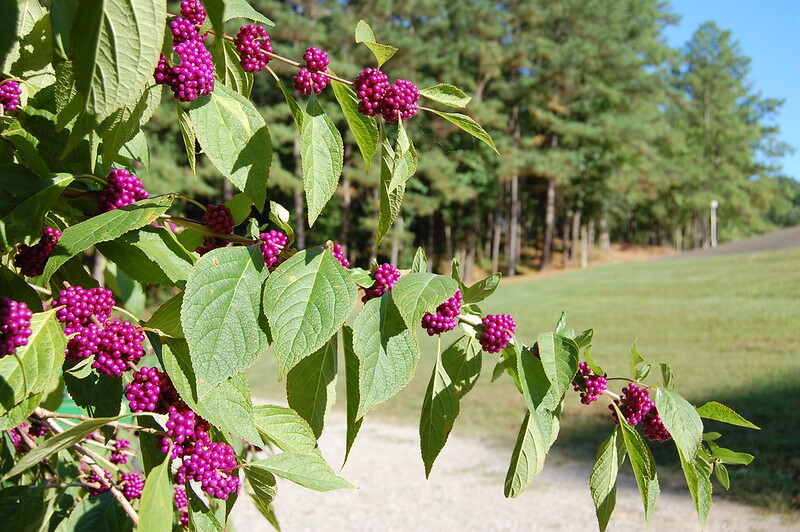
For Alabama natives, beautyberry is a total superstar. Not only are the dense clusters of jewel-toned purple fruits beautiful, but they’re also a great mosquito and flying-insect repellant thanks to naturally-occurring compounds.
Those who spend time outdoors know that beautyberry occurs just about everywhere in the South. What’s great is it doesn’t take much work to maintain it. It grows great in sunny to partially shady spaces as long as it gets plenty of wet, sandy soil. Prune it in late winter to promote new growth and fruiting. Low-maintenance and gorgeous—what more could you want?
- Hardiness zones: 6 – 10
- Sun: Full sun, partial shade
- Soil type: Prefers rich soils but can sometimes grow in sandy soils
- Duration: Perennial
- Height: 3 to 8 feet
- Maintenance: Prune before flowering season to keep the shrub compact
10. Oakleaf Hydrangea (Hydrangea quercifolia)
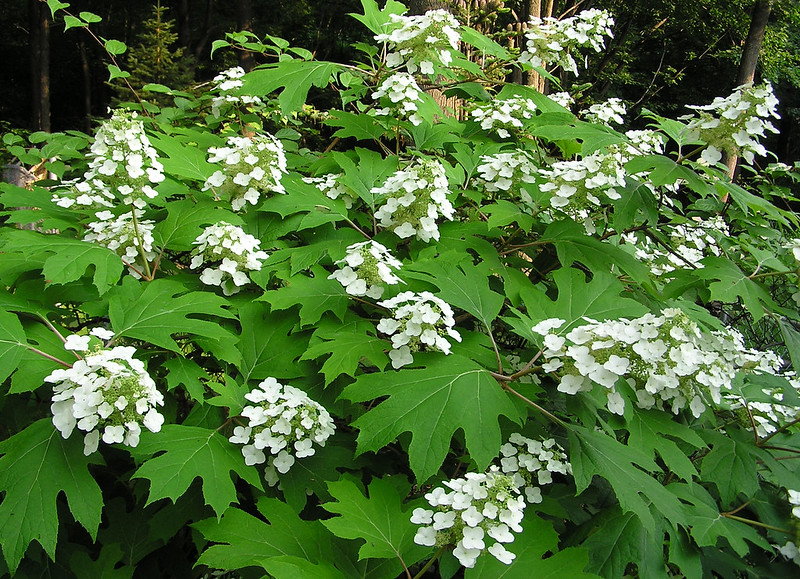
One of the most beloved shrubs in the South, this native hydrangea is a real highlight in any garden. Found throughout Alabama, these beautiful shrubs occur naturally along rivers, streams, and moist woods. They pack a punch of texture in late spring and early summer with their stunning white flower heads.
Reaching heights up to ten feet, these resilient shrubs thrive in rich loamy soil and can tolerate sun to partial shade conditions.
- Hardiness zones: 5 – 9
- Sun: Full shade
- Soil type: Fertile, well-draining soils
- Duration: Perennial
- Height: 6 to 10 feet
- Maintenance: Water during dry periods, prune occasionally
11. Red Buckeye (Aesculus pavia)
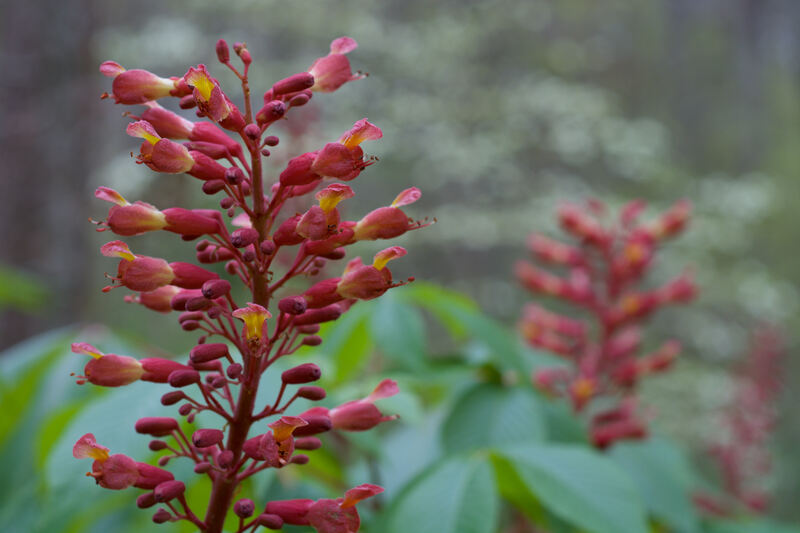
Red buckeyes are small, multi-branched shrubs or small trees standing up to 25 feet tall. Widespread throughout Alabama, this shrub makes itself at home in hardwood forests, near streams, and on rocky slopes.
Easily recognizable with its serrated leaves and vibrant red-orange petals, red buckeyes love partial sunlight. Interestingly, it is believed that this shrub brings luck when you carry its seeds in your pocket. Beware, however, because those lucky seeds, along with the plant’s foliage, are poisonous.
- Hardiness zones: 4 – 8
- Sun: Full sun, partial shade
- Soil type: Any well-draining soil
- Duration: Perennial
- Height: Up to 25 feet
- Maintenance: Water during dry periods
12. Weak Leaf Yucca (Yucca flaccida)
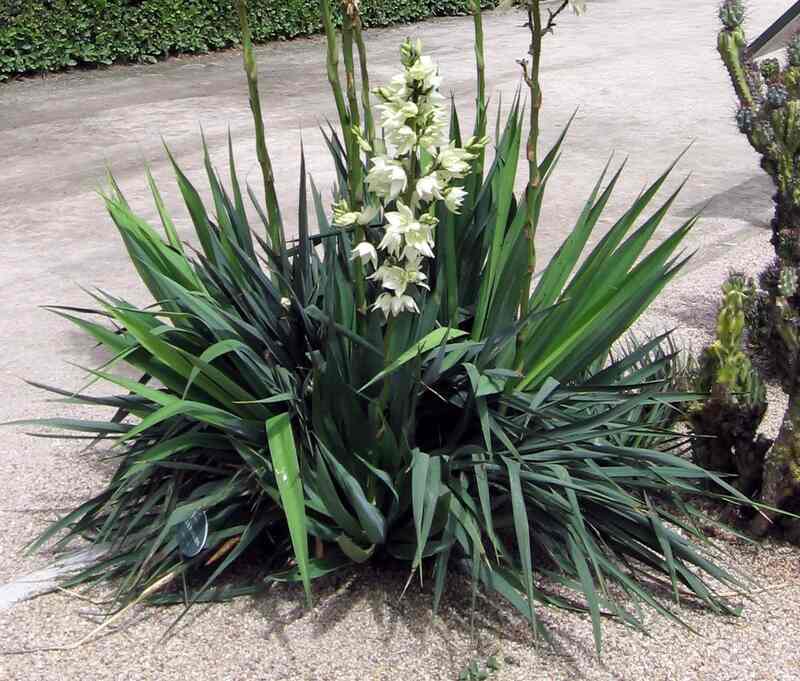
With its tall, thin leaves and eye-catching white flowers during summertime, the weak leaf yucca makes an excellent addition to any garden in need of ground cover. Native to the southeastern United States, this perennial is abundant in Alabama.
It’s fairly easy to care for and tolerant of full sun but prefers sandy, well-drained soils. It also produces offsets from its roots, forming small clumps, and the tall flower panicle will attract yucca moths, which play an important role in the pollination of this beauty. You can find it in nurseries or simply grow it from offsets.
- Hardiness zones: 8 – 11
- Sun: Full sun, partial shade
- Soil type: Sandy, loamy soil
- Duration: Perennial
- Height: 6-7 feet
- Maintenance: Low maintenance, drought tolerant once established.
Native Alabama Trees
Finally, let’s turn to Alabama’s native trees. There is an incredibly large number and variety of trees in this state, all part of the Heart of Dixie’s biodiversity. Here are a few that stand out as great choices for home landscapes.
13. Red Maple (Acer rubrum)
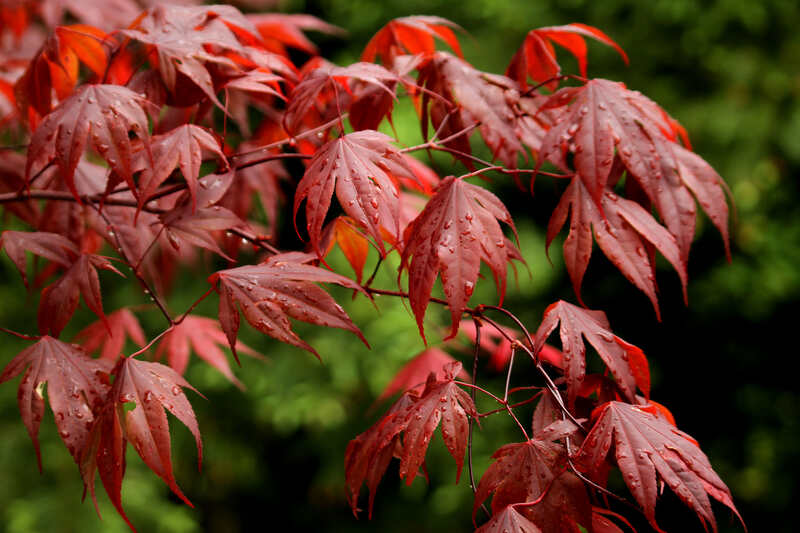
Nothing compares to the beauty of a red maple in full bloom. This gorgeous native tree is also known as the swamp maple because it can easily be found in swamps and other wet areas. It’s a small to medium-sized deciduous tree and can reach heights of up to sixty feet. Its bark is smooth and gray on younger trunks, furrowed and chipped with age.
In the fall, its leaves usually turn brilliant yellow, orange, or red before they drop. In early spring, tiny reddish flowers emerge before the leaves and are pollinated by bees. Red maples typically prefer moist, well-drained soils and can tolerate sun or partial shade.
- Hardiness zones: 3 – 9
- Sun: Full sun/Partial shade
- Soil type: Moist, well-drained soils
- Duration: Perennial
- Height: Up to 60 feet
- Maintenance: Prune in late winter. Water regularly.
14. Box Elder (Acer negundo)
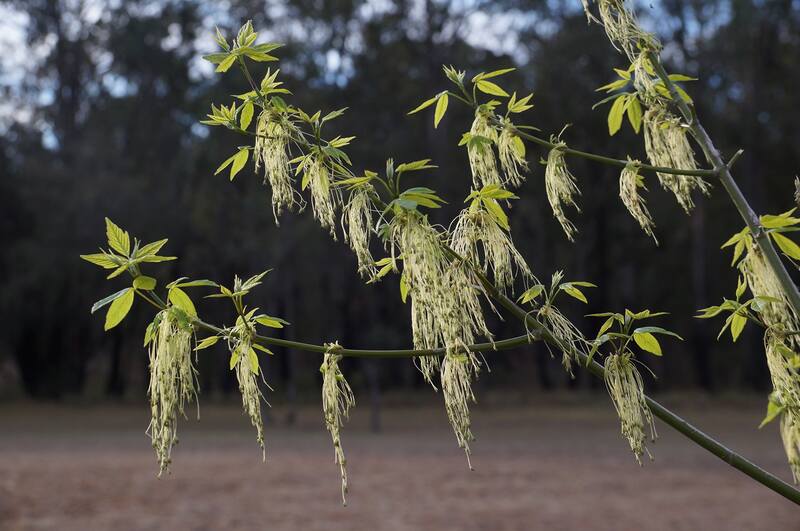
The box elder is a familiar sight in Alabama. This fast-growing native tree stands up to 80 feet tall and 35 feet wide, boasting gray-brown bark and multiple stems. Plus, it can handle drought and wind well.
In spring and early summer, its delicate yellow-green flowers bloom before its odd-pinnate leaflets sprout. This leaf shape makes it the only maple in Alabama with pinnately compound leaves. As autumn rolls in, the leaves turn yellow before the bare branches of winter take over. If you’re looking for one, nurseries often sell the box elder. It will happily grow in most soils.
- Hardiness zones: 3 – 8
- Sun: Full sun/Part shade
- Soil type: Most soils
- Duration: Perennial
- Height: Up to 80 feet
- Maintenance: Water regularly; Prune in late winter to early spring.
15. Dogwoods (Cornus spp.)
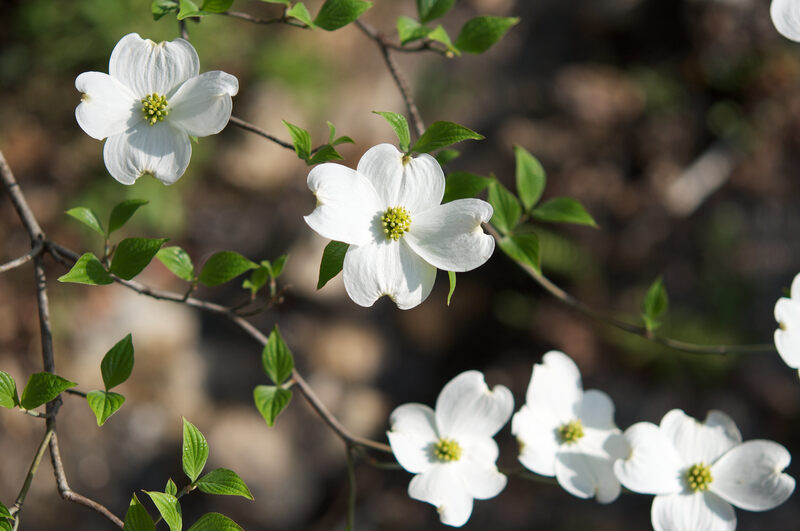
The all-time classic of Alabama native trees is, of course, the dogwood. Its delicate and milky white, pinkish-red, or even deep purple flowers in late springtime are impossible to overlook and have become a real symbol of the South.
Dogwood is a medium-sized understory tree with decorative bark and a conical shape – an iconic sight that you can find in mesic hardwood forests throughout the state. The most popular variety in the state of Alabama is the flowering dogwood (Cornus florida). It grows from 15-40 feet in height and blooms through early spring to late fall.
Dogwoods require partial shade and acidic, rich soil. They tend to be highly susceptible to diseases, so it’s advisable to choose disease-resistant species. The Alabama University Guide on Dogwoods provides a comprehensive overview of the best choice for your own yard.
- Hardiness zones: Varies with species; typically 5 – 9
- Sun: Partial Sun/Shade
- Soil: Rich, acidic soils
- Duration: Perennial
- Height: 15-40 feet
- Maintenance: Water regularly; Keep an eye out for disease
16. Southern Magnolia (Magnolia grandiflora)
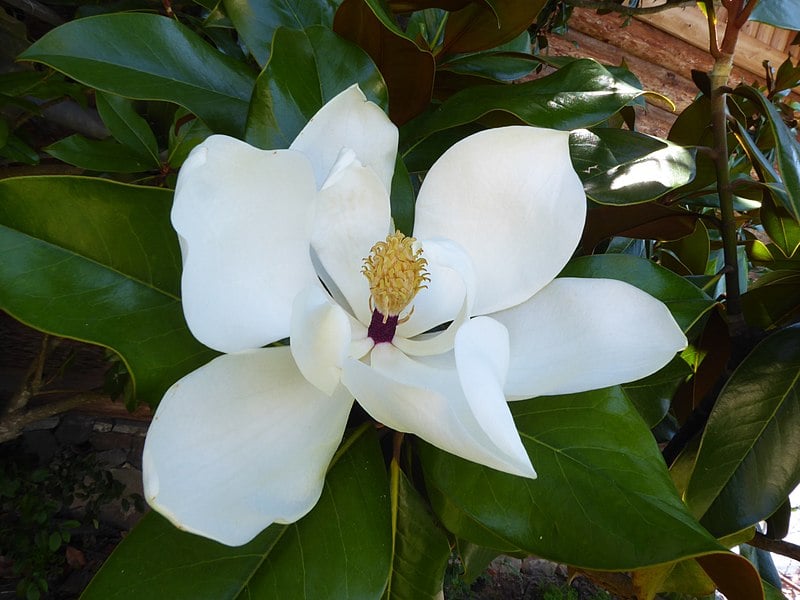
One native that every true Southerner will recognize is the classic Southern magnolia. These majestic trees always put on a grand show with their glossy, deep green evergreen leaves and fragrant white flowers. You’ll often find them in low-lying, wet areas, thriving in full sunlight and well-drained soil.
Southern magnolias are impressively tall and wide, reaching 80 feet high and 60 feet wide. The white blooms will capture your attention and fill the air with their sweet scent as you get closer.
- Hardiness zones: 7 – 10
- Sun: Full sun/Partial shade
- Soil: Well-drained soil, no extreme pH
- Duration: Perennial
- Height: 80 feet
- Maintenance: Prune in late winter; Feed during early spring; Water regularly.
17. Green Ash (Fraxinus pennsylvanica)
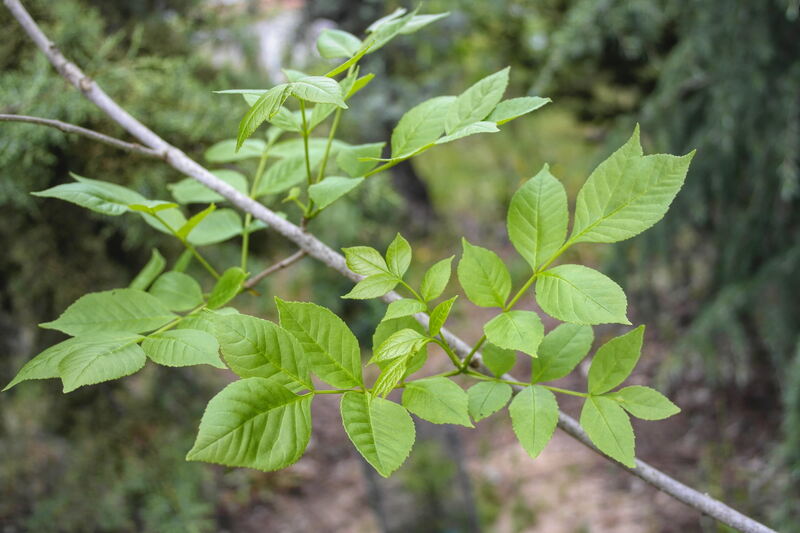
Green ash is a common but beautiful native tree of Alabama. Growing up to 120 feet tall in some cases, it has a rounded canopy that provides plenty of shade. Its compound leaves, which are made up of multiple leaflets arranged in a feathery pattern, have serrated edges and usually turn to a golden yellow in the fall before dropping.
Green ash is popular among homeowners and landscapers due to its attractive shape, adaptability to different soil and moisture conditions, and hard, durable wood. It’s a resilient tree that can withstand storms, drought, and poor soil conditions. However, it can be susceptible to pests and diseases threatening its health, such as the emerald ash borer.
- Hardiness zones: 3 – 9
- Sun: Full sun/Partial shade
- Soil type: Adapts to different soil conditions
- Duration: Perennial
- Height: 60-120 feet
- Maintenance: Apply insecticide if affected by pests; water regularly.
FAQ About Alabama Native Plants
Native plants refer to species of vegetation that were indigenous or naturally occurring in the environment before human settlers arrived. They’ve adapted to their environment and rely on other plants, animals, and microorganisms for survival.
There are many benefits of native plants that make them vital for local ecosystems, such as:
● They help provide food and shelter for wildlife, including many endangered species.
● They maintain the soil and conserve water because they can usually survive on rainfall without much additional irrigation.
● They don’t need expensive fertilizers and pesticides! Since native plants have adapted to the local environment, they can resist Alabama’s pests and thrive in Alabama’s soils naturally.
● They add beauty and vibrancy to landscapes just like any other plant but without as much maintenance.
In Alabama, there is an impressive variety of native plants, with over 3,000 species that are native to the state. The list includes trees, shrubs, wildflowers, and more. You can look up more native Alabama plants in the University of West Alabama’s Alabama Plant Atlas.
It’s the lovely camellia that holds the title of Alabama’s state flower. It was selected to replace the not-so-loved goldenrod many years ago. Though camellias aren’t native to the area, they have a special history linked to Alabama and perfectly represent its lush gardens and stunning landscapes.
Yes, there certainly are endangered plants in Alabama. The Alabama canebrake pitcher plant is one of them. This species is a carnivorous plant that’s only found in central Alabama, but it was much more common in the past. It’s now at risk of extinction due to modern practices like development and agriculture.
To protect this plant species, an Alabama Canebrake Pitcher Plant Committee was formed in 2009, with members from several institutions like Auburn University and Atlanta Botanical Gardens.
Other endangered plants in Alabama include:
● Alabama leather flower (Clematis socialis)
● Leafy prairie clover (Dalea foliosa)
● Georgia rockcress (Arabis georgiana)
Different parts of Alabama are in USDA Hardiness Zones 7b through 9a. When picking plants for your garden, you must choose species suited to these Alabama hardiness zones.
Alabama is home to some of the most diverse and beneficial native grasses in the country, such as:
● Eastern gamagrass
● Switchgrass
● Little bluestem
● Indian grass
While these grasses offer great drought resistance and provide shelter for wild animals like deer, they’re not ideal for an aesthetically pleasing yard. The best grass types for Alabama lawns would be Bermudagrass or tall fescue.
To take care of those grass types and keep your lawn pristine and healthy, follow our Alabama lawn care schedule.
Some native plants are prolific and not-so-desirable – we call these weeds. Weeds are a common problem in the Heart of Dixie, and the climate supports many different types. Common weeds in Alabama include:
● Chickweed
● Annual Bluegrass
● Goosegrass
These weeds can quickly take over your lawn or flower beds, so it’s essential to identify them ASAP so you can properly manage them.
Final Thoughts
Alabama has some truly amazing native plants that provide wonder and beauty. From majestic wildflowers to leafy trees, these plants help the environment and make outdoor spaces look fantastic. But before selecting one or more of these native species, be sure to do your research and make sure they’re being planted in the right conditions.
Talk to an Alabama landscaping expert if you need help selecting plants for your landscape. Whether you’re in Montgomery, Birmingham, Huntsville, Mobile – or anywhere else in the great state of Alabama – LawnStarter can connect you with passionate lawn care and landscaping pros with helpful advice.
Main Image Credit: Plant Image Library / Flickr / CC BY-SA 2.0
